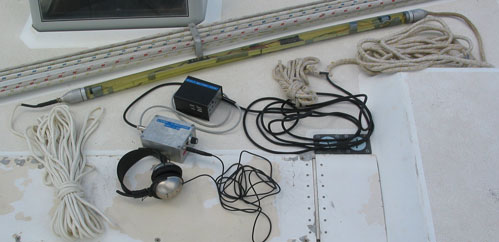|
Single element hydrophones are broadly omni-directional, but a simple two channel two element system can provide some directional information by exploiting the stereo effect. If the piezos are one behind the other and separated by 750mm or more and we wear headphones our ears can distinguish which received the sound first and form a rough idea of how far ahead or behind the boat’s beam it came from. If the sound persists, changing course by 90 degrees can then reveal which side it was originally on, and perhaps an approximate direction of the source. Multi-element arrays in conjunction with computers can do this much more accurately, and with software that identifies characteristic echo clicks allow researchers or whale watchers to home in on particular species that are not even on the surface.
The photo above shows the same nose and tail cones built for my original towing hydrophone, but fitted to a meter long PVC tube, as a stereo towing hydrophone.
The photo above shows one of two DIY piezo bender hydrophones, with its associated pre-amplifier, secured to a length of white rigid plastic with a couple of stretched rubber O-rings. The plastic separated the two hydrophones by the desired amount for a stereo system, but probably also acoustically links them which is not ideal. I did not in the end deploy this system, deciding instead to replace the DIY components with a pair of SesorTech SQ12 bender style hydrophones and a pair of SensorTech SA02 pre-amplifiers. The photo above show the associated stereo amplifier project box containing a pair of "canakit" amplifiers,www.canakit.com which use an LM380 chip. The two individual potentiometers in the kit were replaced with a double gang variable potentiometer. Their "audio in" connections were fed with the outputs from towed hydrophone, and the output was to be fed to the line-in connection of my laptop. This combination produced a very sensitive system with good volume for a speaker, but unfortunately during its first field trials (on Volo in New Caledonia in October 2002) the amplification proved unstable. There was nothing I could do with the resources on board to fix this, so in retrospect I should have stuck with my DIY gear, or at least brought it along for the trip just in case! Squelch Circuit?
|

